Review: 40th Anniversary HarnWorld Hardcover
Edit: also check out the review by my friend Austin Conrad!
Columbia Games usually runs simple, straight-to-the-point, and fast-shipping Kickstarters. This latest one wasn’t any different: the 40th Anniversary HarnWorld hardcover showed up on my doorstep last week, a few months after it was successfully funded. Let’s have a look!
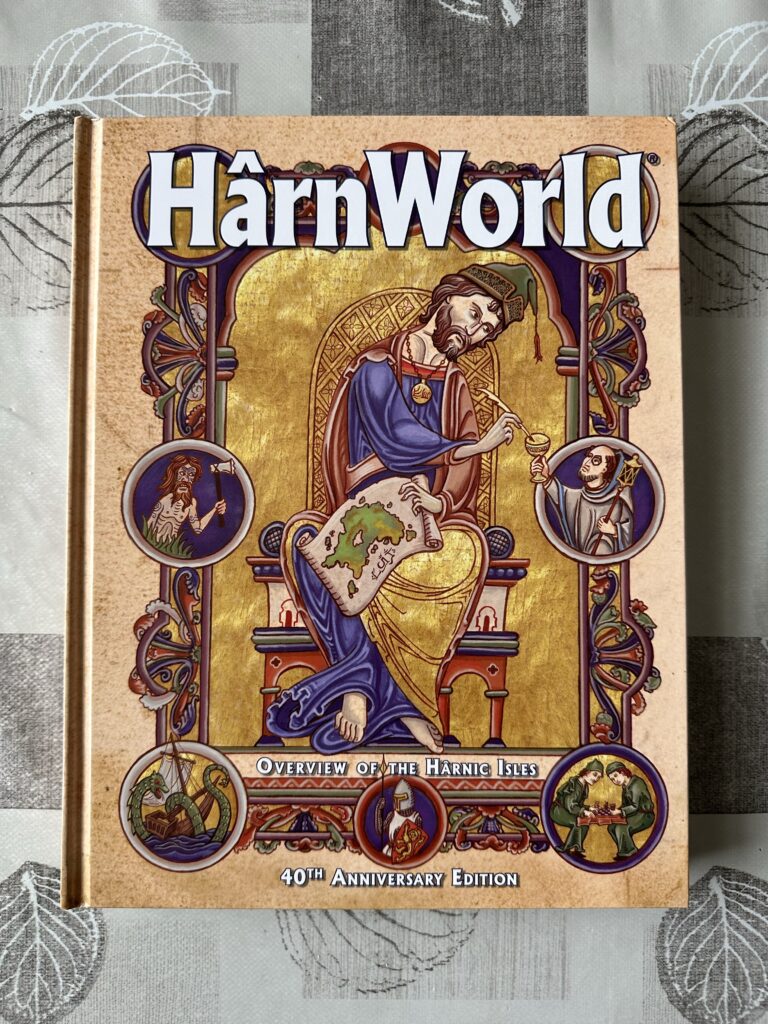
General Statements
For those who might not know, this can be considered the “basic setting book” for Harn, a game setting heavily inspired by the medieval British Isles, with some variable-size fantasy on top. It has no game mechanics (that is, only setting information), so people usually play in Harn with a variety of TTRPG systems.

This is the fifth Harn hardcover that Columbia Games has put out via Kickstarter. Like the previous hardcovers, this one comes with high quality paper and excellent printing. And when I say “high quality paper”, I mean it. This is some thick stuff: the Harnworld hardcover comes up to about 280 pages or so, but it’s as big as, say, the 455 pages-long Cyberpunk RED rulebook. If you’re looking to save shelf space this isn’t the book for you, but if you want something durable, especially for a reference book you might flip through often, this is great news.
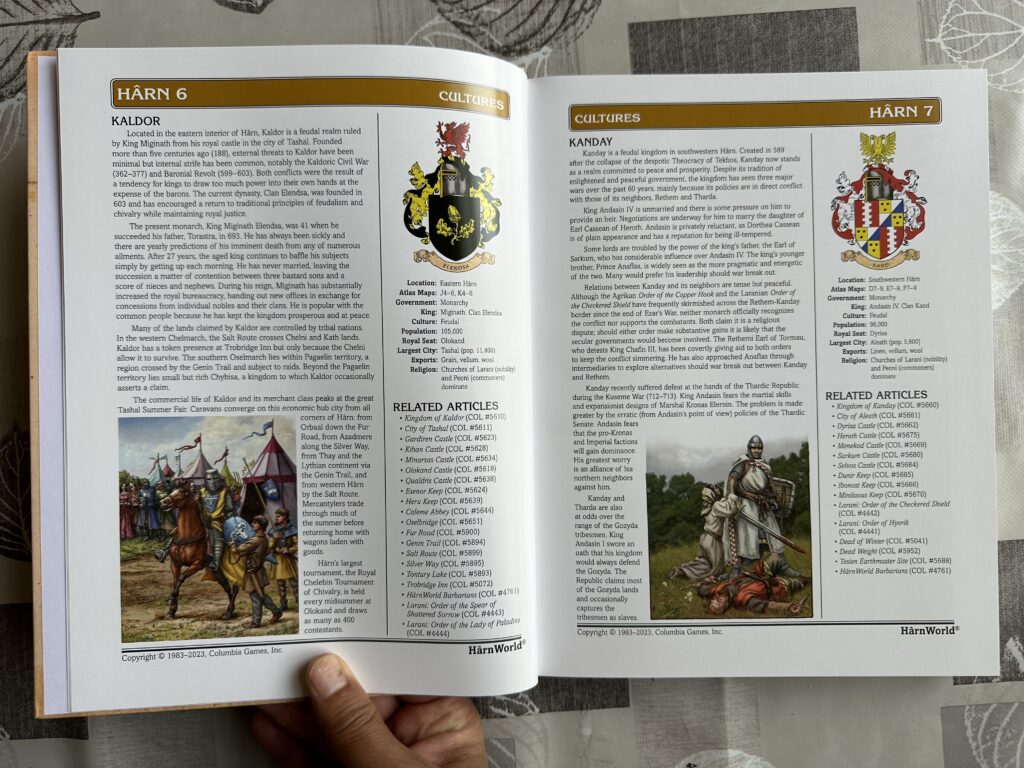
The layout is one of the unsung wonders of Harn books: a lot of things fit on one or two pages, and very often those two pages are facing pages. This means that most topics can be scanned in one go without having to flip pages back and forth. Sidebars never continue to the next page. Kingdoms and religions all fit on one page. And so on.
I imagine that there has been a lot of love given to both text and layout to make this happen. Not many people might realize it because that’s the sort of detail you only notice when something is wrong.
Nerds and Page Numbers
To the uninitiated, the way Harn material is arranged is a bit weird: it comes in various standalone “articles” ranging from a few pages (for articles about, say, Heraldry or Taverns, or small location articles like a bridge or a keep) to 50 pages or more (for articles about a kingdom or a capital city). These articles are sold separately in PDFs or as loose leaf perforated paper meant to be assembled in 3-ring binders based on what you need for your game. Is this super nerdy? Yes, it is super nerdy. And old-school. It’s frankly too nerdy and old-school for me. Anyway, cross-references are done by article name and page, like, say “the genealogy of Clan Curo is in Gardiren 4“, which directs you to the article about Gardiren castle, page 4.
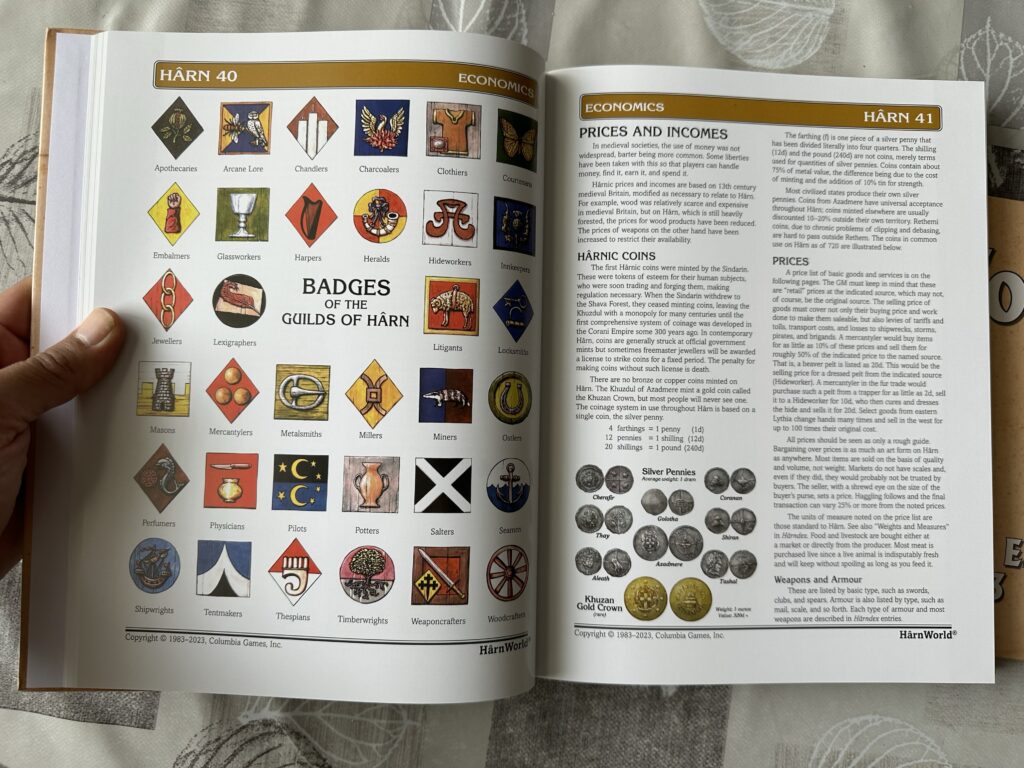
Now, the reason I’m telling you all this is because that will explain one of the most baffling things about these hardcovers: they have no table of contents or index section. This is very unfortunate, but also understandable given the unusual conventions that the Harn fandom has used for 40 years. Both a table of contents and an index would require page numbers, but page numbers don’t work when you have multiple articles in a book, with each article resetting its page numbers to 1.
Still, I think a table of contents and index could have worked. The article name features prominently at the top of the page (see above, these are pages 40 and 41 of the “Harn” article), so it’s easy to flip the book to a given article, and find the page from there. Both table of contents and index could have used the traditional referencing system. It could even have been made easier by colour-coding each section and using page edge bleeds to easily find a section. Some RPG rulebooks actually use this technique to great effect.
Either way, what’s done is done: none of the Harn hardbacks have table of contents or indexes, and you might wonder why. Now you know why, and, like me, you can still wonder why anyway. If you have some searching to do, you might want to use the PDFs.
Contents
Okay so this book contains the “Harnworld” article (about 80 pages), the “Harndex” article (a whooping 148 pages), the “Lythia” article (32 pages), and the “Kethira” article (10 pages).

The World of Harn
The Harnworld article describes the island of Harn (and other small islands around it). You get the usual stuff, such as the various cultures, “barbaric” tribes, and “civilized” nations found on the island, the religions they follow, their political and societal structures, etc. Since this is a stand-in for medieval Britain, you’ll see a fair amount of information on feudalism, city markets, trade routes, guilds, raiders, and so on.
What I like about Harn material is that it tends to be clearly presented, factual, and straight to the point. Some might describe it as academic and boring, but for me it’s often a good breeding ground for game ideas because I don’t have to spend any time trying to “grok” it. I enjoy evocative high concept fantasy like the next guy, but sometimes I also like a setting that simply gives me a “baseline” upon which I’ll be the one coming up with the big plot and big ideas.
On the other hand, the least interesting section of the Harn article for me was probably the obligatory history section. It’s 17 pages long, which, depending on what other game settings you play and enjoy, might be 16 pages too long, or refreshingly succinct. I didn’t really care much for it while I was skimming it, but I did find it useful to go back to once other bits of texts started referring to past events. In particular, a few recent events are used to fuel various campaign ideas.

Despite being a sort of medieval Britain emulation, Harn of course differs from its inspiration in several ways because, well, it’s a fantasy setting.
For example, you’ve got some orc stand-ins called the Gargun. You have polytheism a bit similar to, say, the Iron Age (Ancient Greece, the Romans, etc.) where people acknowledge many different gods but only worship one themselves. There is no stand-in for Christianity, and most Harnic kingdoms have at least two main gods.
Some people say that Harn is a “low magic setting” but I’ve heard Grant Dalgliesh of Columbia Games prefer the term “magic rare setting”. That is: most people don’t have magic, but some individuals can get really powerful. Clerics of certain religious orders and mages of the Shek-Pvar esoteric orders are where you’ll typically find magic. Overall, I like how magic is described as a mysterious and obscure thing to the common folk. Similarly, fantasy creatures are described as uncommon, dangerous, and often poorly known.
This makes Harn a setting where the woods are a scary place, where superstition and magic and faith blend into each other, and where you don’t ask about the Shek-Pvar school on the hill where strange lights can be seen on moonless nights. High epic fantasy where dragon-borns and elves walk down the street, thieves disappear in a puff of smoke, and mage hands are almost as common a shovels is fun, sure, but if that’s what you want to play next week, grab another book.
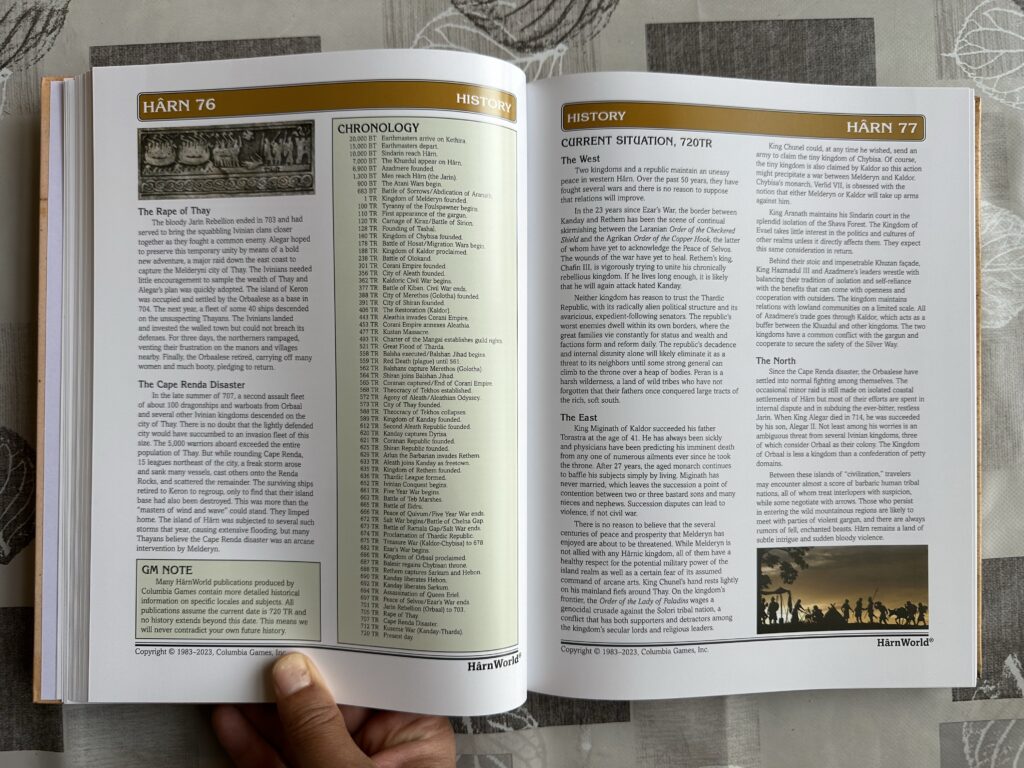
One fun fact is that Harn comes with its own “ancient aliens” trope, here known as the “Earthmasters”. They have old, obscure, and dangerous technology lying around. This includes teleportation gates to other places on Harn’s planet (Kethira), and also to other planes of existence, including Yashain, where the Harnic afterlife is believed to be, and Terra, which is… well, Earth. The idea here is that if you want to teleport your current campaign to Harn, or if you want a premise that resembles the good ol’ Dungeons & Dragons cartoon series, you can make your player characters emerge, confused, from an Earthmaster teleport gate. That’s in fact a popular campaign premise in the Harn fandom as far as I understand, and nicely provides players with characters who don’t know anything about Harn, therefore cutting down a lot on lore exposition.
Another fun fact is that it’s always year 720 on Harn. Well, in the written material, at least. For the past 40 years, all the Harn articles have described the world of Harn as it is in the year 720. There is no “ongoing metaplot” or other such shenanigans, and it’s up to you to figure out how it evolves from here. Figuring out in play how Harn evolves seems to be a common thread among the Harn fandom, and each gaming group’s “own” Harn is called their “p-Harn” (i.e. “parallel Harn”, an alternate future timeline). If you’ve played in Glorantha, you’ll find that this is similar to YGWV (“Your Glorantha Will Vary”).
The Book is the Index
When I mentioned that there was no index in the Harn books, this wasn’t 100% true. This particular one does technically have an “index”, and it takes up much of the book itself! That’s the Harndex article, taking up a bit more than half the page count.
As you might expect, this is an alphabetical list of all kinds of names, terms, or concepts that are deemed important enough to know. Each entry ranges from a sentence to several paragraphs, possibly including a drawing or small map.
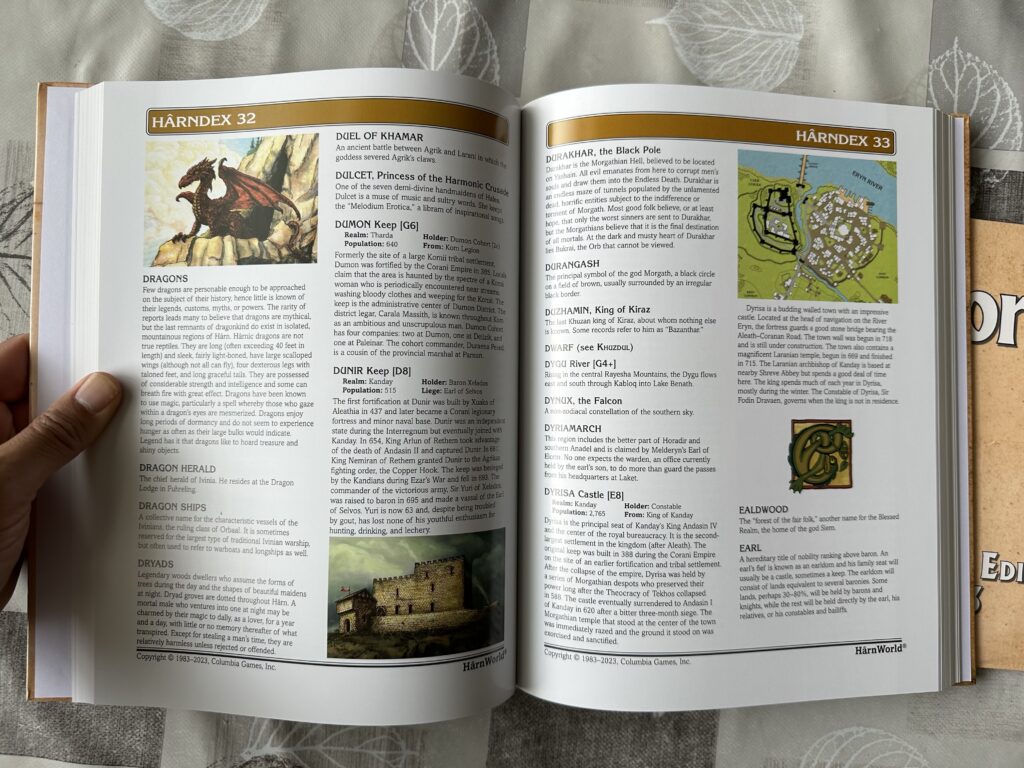
For instance, in the photo above, we have “bestiary” entries about what Dragon and Dryads are in this setting, entries about Dunir Keep and Dyrisa Castle (respectively a fortified location and a feudal village in the Kingdom of Kanday), an entry about Durangash (a symbol related to the evil god Morgath), another one on what the title of “Earl” means, and so on.
Harndex is super useful to make sense of Harn as a game setting. If I ever run into something I’m not sure about, there’s a big chance that it’s in the Harndex article. And if it’s not, a PDF search finds a relevant reference inside another entry anyway. This means that, yes, I wish there was an index for the Harndex too! Is that too meta? Maybe? I’m crazy like that.
On the other hand, reading an index can be pretty tedious. I enjoy flipping pages to a random entry and going from there, but this whole chapter might only have real value once you start buying other Harn material that contains things you may want to look up in Harndex.
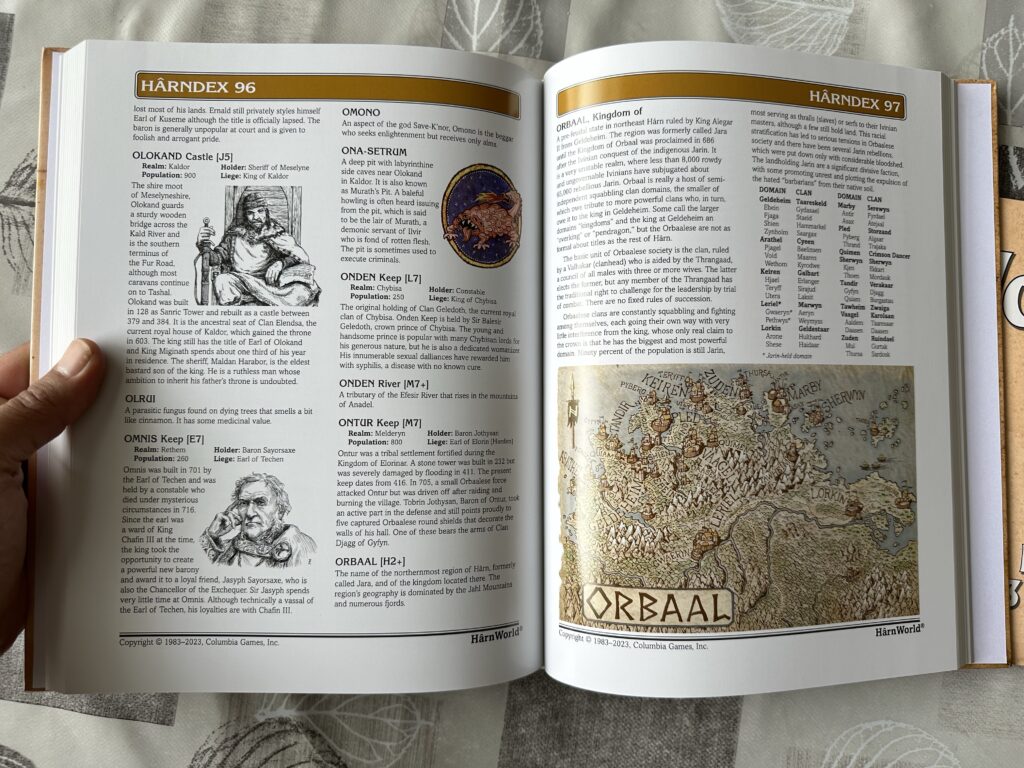
Another thing to know about Harn material is that it often strives to include at least one or two adventure seeds on each page. People familiar with, say, the Ubersreik city book for Warhammer Fantasy Roleplay know how great that is. This design tends to mostly transpire from the location articles (kingdoms, cities, keeps, etc.), but you’ll find a glimpse of this in the Harndex. This is because it contains many small entries for notable locations in Harn. In many cases, one adventure seed or story idea is mentioned in these entries. Of course, if you were to grab the dedicated article for that location (if it exists) you would probably find an expanded version of this adventure seed, plus several others… but it’s nice that the Harndex gives you a little taste.
Other Articles
The few remaining pages of the book include an article on Kethira, the planet on which Harn resides, and an article on Lythia, the main continent on that planet.
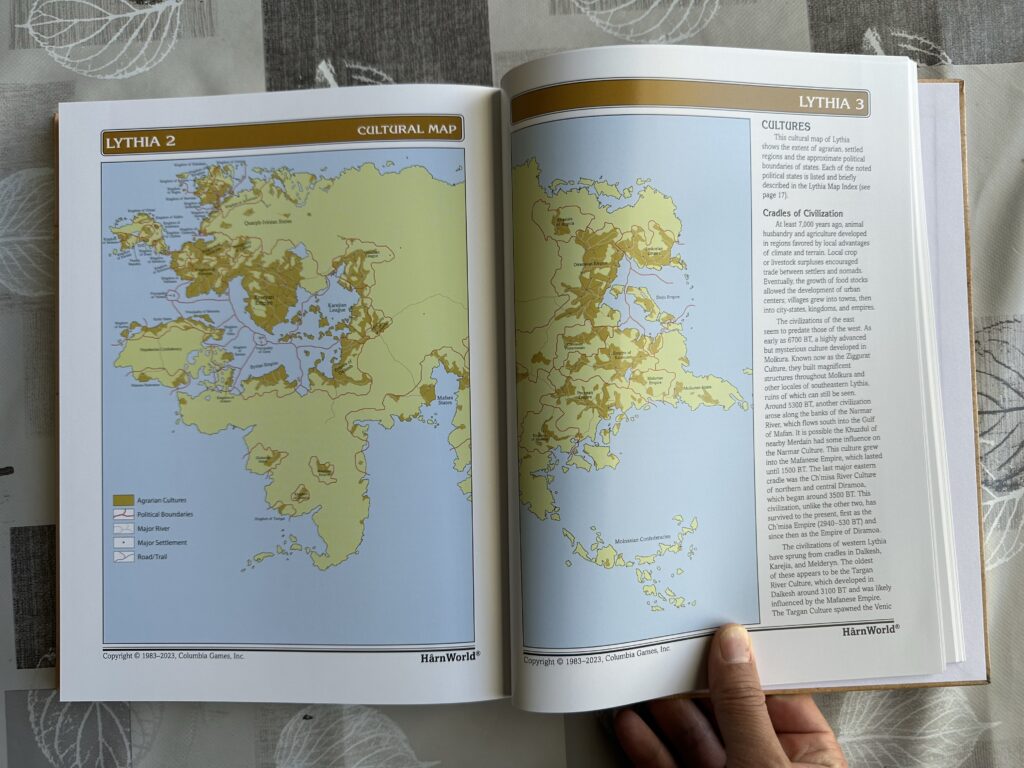
It will take you about 10 seconds of looking at the continental and planetary maps to realize that Harnworld effectively looks like Earth as drawn by a drunken sailor with fine motor function problems. This of course is done on purpose: it makes it easy to reach for Earth references and tropes for any given place without having to ingest any obscure lore. If you’ve played in Theah with 7th Sea (maps here), you’ll know the benefits of this approach.
The article on Lythia is like a shorter version of the Harnworld/Harndex structure. It has a very high level overview of the Lythian cultures and nations (with analogues of medieval Europe, Africa, and Asia) filling about 16 pages of text, maps, graphs, and more. This is followed by an index taking about the same amount of pages.
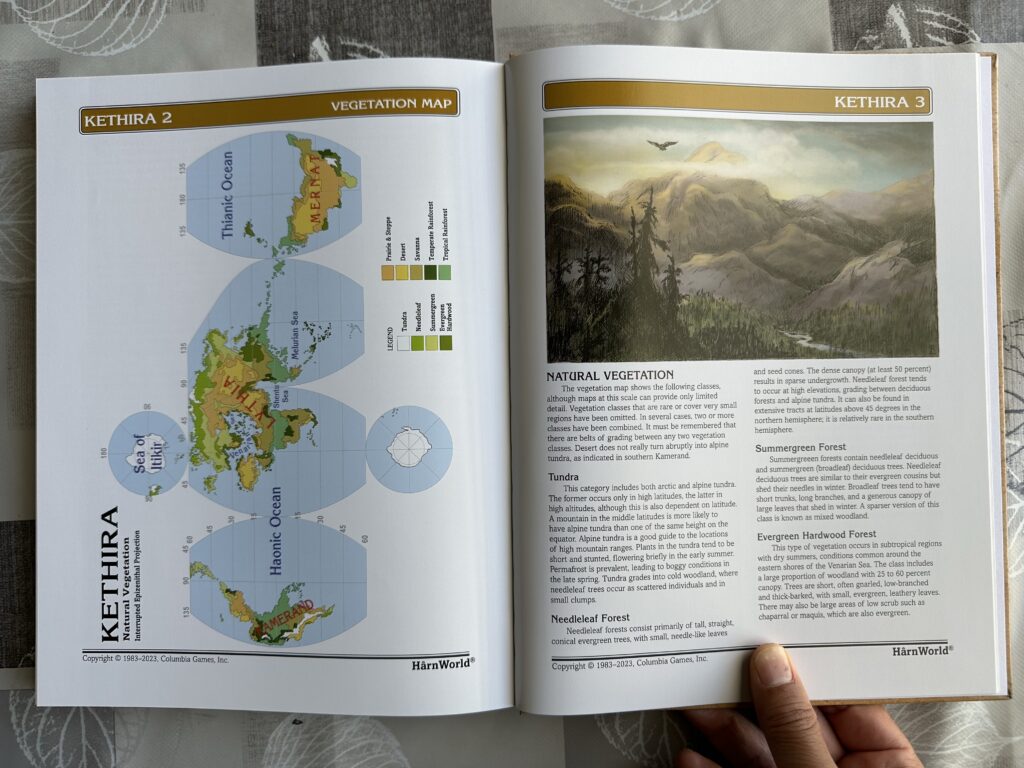
The article of Kethira takes an even higher level and shorter view of the setting, with generalities about ecosystems, oceans, astronomy, and so on, plus a quick glance at the Kethiran analogues for the American and Australian continents.
Harn Cartography
Of course, Harn is well known for its cartography, and this Kickstarter didn’t disappoint. The hardcover is accompanied by an envelope containing two maps, one of Lythia, and one with the classic map of Harn.
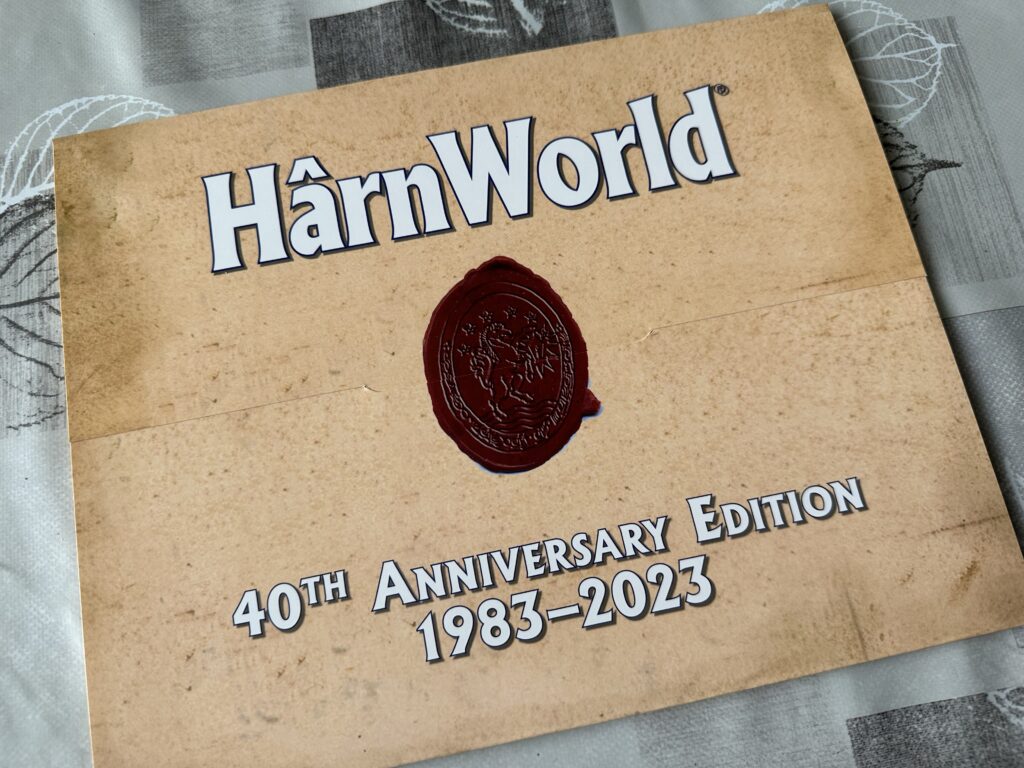
You can tell that Columbia Games are trying to be serious about cartography, since the Lythia map claims to use an “Interrupted Epizenithal Projection”. In practice, if you actually dig into proper map projections you’ll realize that this isn’t quite right but hey, bonus points for trying.

The map of Harn is big! Not as big as the awesome vinyl map that Columbia Games also sells, but big nonetheless. Big enough to make an impression on the game table, I’m sure.
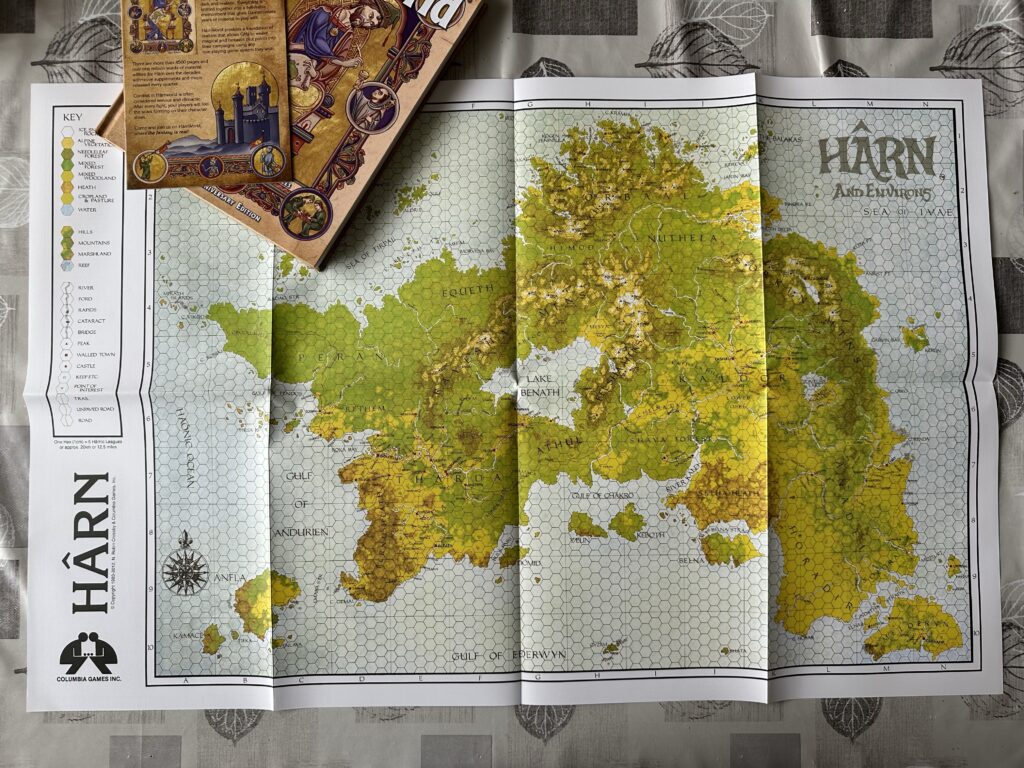
Parting Thoughts
Overall, this is a solid hardback of Harnworld material. Judging it from the perspective of someone new to Harn is a bit difficult since I was already familiar with most of it through the individual PDF articles, but a couple thoughts come to mind.
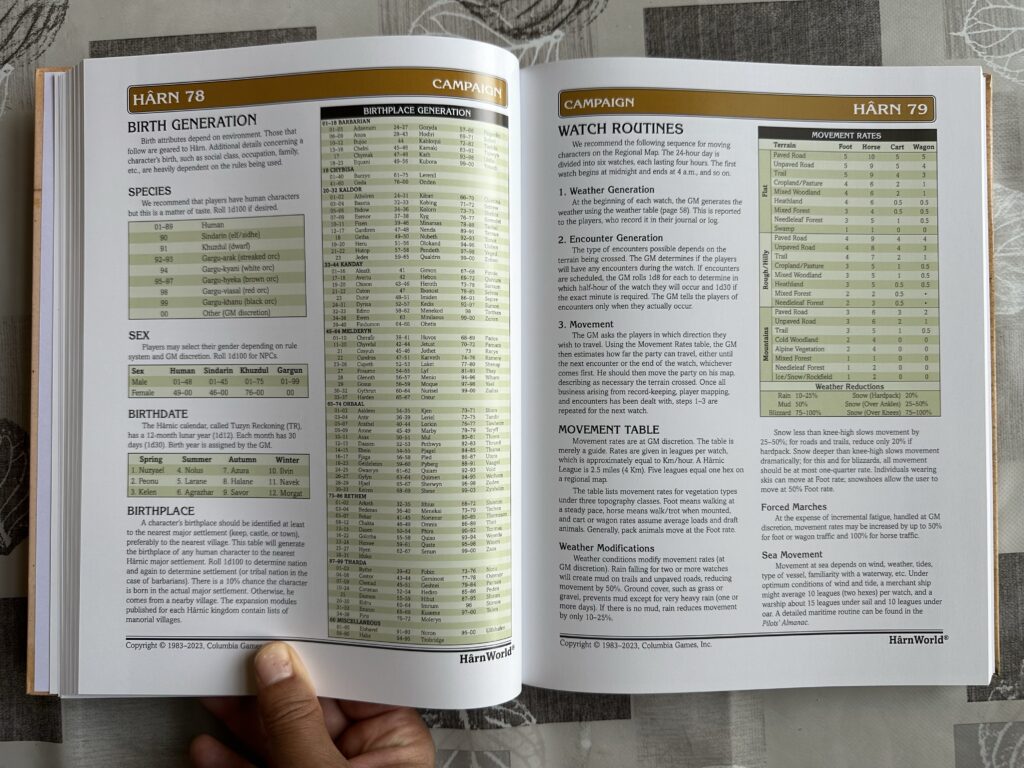
As I said earlier, this presents a baseline for a low-fantasy setting inspired by medieval Britain. It doesn’t provide any campaign framework or practical gaming material per se. In fact, it could be mistaken as some sort of resource companion for a series of novels or movies if not for a few references to gaming, such as the “Why Use HarnWorld” sidebar in the introduction, the very funny “The Problem with Players” sidebar on Harn 24, or the character background tables on Harn 78-79.
Given the modern gaming scene where RPG books tell you exactly what you’re going to play (“Homeric heroes going from island to island where adventure awaits”, “horny teenage monsters getting in trouble”, or “agents of Queen Elizabeth investigating paranormal mysteries across England”), a setting with nothing to do in it out of the box will feel nostalgic and liberating to some, dated and useless to others.
Harnworld doesn’t leave you exactly out to dry on this. You’d have to be a very unimaginative person to not find a campaign idea here: political intrigue in Kaldor as a succession crisis draws near, Viking-ish invaders in Orbaal struggling to make a home in Harn, Laranian paladins growing disenchanted by the crusade against the Solori tribes, Pamesani gladiators trying to earn their freedom in the Thardic Republic, Lord-of-the-manor Pendraon-style seasonal campaign, etc. But this is definitely one of those “make your own fun” sort of settings. If you prefer a more “opinionated” setting designed specifically for a given core activity through which you are guided, you should read other books (if you liked the previously cited campaign ideas, check out, respectively, Agon, Monsterhearts, and The Dee Sanction).

If you’re interested in Harnworld, the, ahem, “retro-looking” Columbia Games website has a 5-step introduction for you. The rest of the website is weirdly labyrinthine, so if you’re looking for something specific, here are all the Harn products. The Harnworld hardcover in particular is here.
Don’t forget that you can subscribe to all new Harn articles with Harnquest, which comes with a 50% discount on all already published PDFs. So if you’re going to spend more than $40 on Harn PDFs, you might as well get the $20/quarter digital-only subscription first and cancel it later.
Happy exploration, and happy gaming!